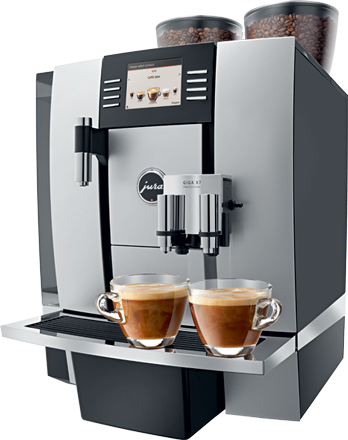
This image has format transparent PNG with resolution 348x440.
You can download this image in best resolution from this page and use it for design and web design.
Coffee machine PNG with transparent background you can download for free, just click on download button.
Coffeemakers or coffee machines are cooking appliances used to brew coffee. While there are many different types of coffeemakers using several different brewing principles, in the most common devices, coffee grounds are placed into a paper or metal filter inside a funnel, which is set over a glass or ceramic coffee pot, a cooking pot in the kettle family. Cold water is poured into a separate chamber, which is then boiled and directed into the funnel. This is also called automatic drip-brew.
For hundreds of years, making a cup of coffee was a simple process. Roasted and ground coffee beans were placed in a pot or pan, to which hot water was added and followed by the attachment of a lid to commence the infusion process. Pots were designed specifically for brewing coffee, all to try to trap the coffee grounds before the coffee is poured. Typical designs feature a pot with a flat expanded bottom to catch sinking grounds and a sharp pour spout that traps the floating grinds. Other designs feature a wide bulge in the middle of the pot to catch grounds when coffee is poured.
In about 1889 the infusion brewing process was introduced in France. This involved immersing the ground coffee beans, usually enclosed in a linen bag, in hot water and letting it steep or "infuse" until the desired strength brew was achieved. Nevertheless, throughout the 19th and even the early 20th centuries, it was considered adequate to add ground coffee to hot water in a pot or pan, boil it until it smelled right, and pour the brew into a cup.
There were many innovations from France in the late 18th century. With help from Jean-Baptiste de Belloy, the Archbishop of Paris, the idea that coffee should not be boiled gained acceptance. The first modern method for making coffee using a coffee filter—drip brewing—is more than 125 years old, and its design had changed little. The biggin, originating in France ca. 1780, was a two-level pot holding the coffee in a cloth sock in an upper compartment into which water was poured, to drain through holes in the bottom of the compartment into the coffee pot below. Coffee was then dispensed from a spout on the side of the pot. The quality of the brewed coffee depended on the size of the grounds - too coarse and the coffee was weak; too fine and the water would not drip the filter. A major problem with this approach was that the taste of the cloth filter - whether cotton, burlap or an old sock - transferred to the taste of the coffee. Around the same time, a French inventor developed the "pumping percolator", in which boiling water in a bottom chamber forces itself up a tube and then trickles (percolates) through the ground coffee back into the bottom chamber. Among other French innovations, Count Rumford, an eccentric American scientist residing in Paris, developed a French Drip Pot with an insulating water jacket to keep the coffee hot. Also, the first metal filter was developed and patented by a French inventor.
An electric drip coffee maker can also be referred to as a dripolator. It normally works by admitting water from a cold water reservoir into a flexible hose in the base of the reservoir leading directly to a thin metal tube or heating chamber (usually, of aluminium), where a heating element surrounding the metal tube heats the water. The heated water moves through the machine using the thermosiphon principle. Thermally-induced pressure and the siphoning effect move the heated water through an insulated rubber or vinyl riser hose, into a spray head, and onto the ground coffee, which is contained in a brew basket mounted below the spray head. The coffee passes through a filter and drips down into the carafe. A one-way valve in the tubing prevents water from siphoning back into the reservoir. A thermostat attached to the heating element turns off the heating element as needed to prevent overheating the water in the metal tube (overheating would produce only steam in the supply hose), then turns back on when the water cools below a certain threshold. For a standard 10-12 cup drip coffeemaker, using a more powerful thermostatically-controlled heating element (in terms of wattage produced), can heat increased amounts of water more quickly using larger heating chambers, generally producing higher average water temperatures at the spray head over the entire brewing cycle. This process can be further improved by changing the aluminium construction of most heating chambers to a metal with superior heat transfer qualities, such as copper.
Throughout the latter part of the 20th century, many inventors patented various coffeemaker designs using an automated form of the drip brew method. Subsequent designs have featured changes in heating elements, spray head, and brew-basket design, as well as the addition of timers and clocks for automatic-start, water filtration, filter and carafe design, a "drip stop" feature to pause the flow of brewed coffee when the carafe is removed, and even built-in coffee grinding mechanisms.
In this page you can download free PNG images: Coffee machine PNG images free download